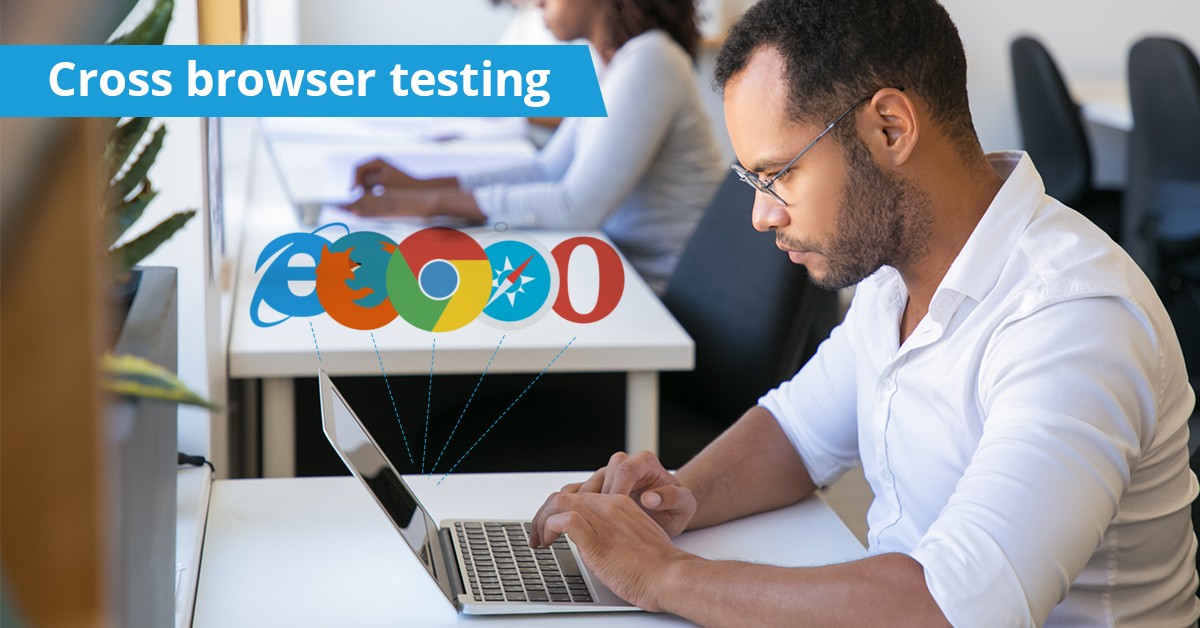
All You Need To Know About Cross Browser Testing
Summary
Explore cross-browser testing essentials in this blog to guarantee a seamless website experience on all browsers and devices – crucial for web developers.
Cross Browser testing is a kind of non-functional testing performed to check whether your website works as expected when accessed through different Browser-OS combinations (Firefox, Chrome, Edge, Safari, on different Oss like Windows, macOS, iOS and Android.), different devices (smartphones, tablets, desktops and laptops etc.) and with assistive tools (screen readers). It tests your website or application in multiple browsers and makes sure that it works consistently, as intended, without any dependencies or compromises.
This testing enables the website to deliver a uniform user experience on a diverse range of browsers/devices. It is applicable to both web and mobile applications. And, typically, the customer-facing applications undergo this testing.
Cross browser testing can be run:
- During the process of development: Before moving the changes on to production, developers in Continuous Integration pipelines test new features to ensure compatibility across different browsers.
- In Staging/Pre-Release: QA teams run this test for every Release Candidate to ensure that there are no browser compatibility issues cropping up in the latest version of the website.
Table of Contents:
- The Reason We Do Cross-Browser Testing
- Who Performs Cross-Browser Testing?
- Features Analyzed in Cross-Browser Testing
- How Browsers Are Selected for Testing?
- How is Cross Browser Testing Done?
- When is Cross Browser Testing Done?
The Reason We Do Cross-Browser Testing
Browser vendors follow Open Web Standards and they each render HTML, CSS, and JavaScript in different ways: but thoroughly debugging the source code of the website alone will not work to ensure that it will look and function as expected on different browsers/different versions of a single browser. Cross browser testing helps with this by pinpointing browser-specific compatibility errors so that they can be debugged quickly. This way, a significant part of the target audience are not left out just because the website does not work on their browser-OS.
Who Performs Cross-Browser Testing?
Typically, anyone who develops for the Open Web would perform cross browser testing. One need not know coding is not needed to use the interactive cross browser testing tools.
- Usually, it is the QA team that executes test scenarios on different browsers to ensure that the build matches the browser compatibility benchmarks.
- The UI teams also run cross browser tests to check how the front-end of the website functions on different devices.
Features Analyzed in Cross-Browser Testing
While compatibility testing includes everything, there exists a time constraint. A test specification document outlines the essentials such as a list of features to test, the browsers/versions/platforms to test to verify if it meets the compatibility benchmark, timelines, and budget.
- Ensure that basic functionality works on most of the browser-OS combinations, such as the working of dialog boxes and menus, the acceptance of inputs of all form fields, correct handling of first-party cookies, and seamless touch inputs for mobiles/tablets.
- In terms of design, test if the website’s fonts, layouts, and images match the design team’s specifications.
- Check if the website complies with Web Content Accessibility Guidelines (WCAG) to enable differently-abled users to access the website and thereby ensure accessibility.
- Check for a fluid design, one that fits different screen sizes/orientations.
Also Read: Essential Website Development Tools Every Developer Should Know
How Browsers Are Selected for Testing?
A mind-boggling number of browsers, devices, and operating systems render it impossible to test on all browser-OS combination. So, it would be more feasible for the testing efforts to maximize the website’s reach in the target market. So, the choice can be based on:
- Popularity: Identify the top 10-20 most popular or commonly used browsers and pick the top two platforms, e.g., Android and iOS in order to maximize your reach in the target market.
- Research and Analysis: Find out the website’s traffic stats as captured by Google analytics or any other analytics tools and break them down by device/browser. This helps identify the most commonly used browser-OS combinations and the devices used by the target audience.
A rule of thumb is to prioritize testing on all browser-OS combinations with over a 5% share of traffic.
The decision about which browsers and platforms to test on is typically made by the Business and Marketing teams (or the client).
How is Cross Browser Testing Done?
Here’s a look at the steps involved:
- Baseline establishment: Before beginning cross browser testing, all the design and functionality tests are run on the primary browser-usually Chrome- to get an idea of how the website was originally intended to look and feel.
- Creation of a testing plan and the selection of browsers-OS combination: The test specification document helps outline exactly what will be tested, and the browser-OS combinations are chosen based on both popularity and site traffic analysis.
- Execution: Manual vs. Automated: In manual testing, human testers sequentially act out test scenarios and there is room for error. Also, it is a time-consuming process, taking anywhere between a few hours and several weeks to complete, depending on the test scenarios. In automated testing, human interactions are ‘automated’ via code. QAs could write a single test script using automation tools like Selenium, and execute a test scenario on multiple different browsers, as many times as needed. There is precise error-reporting, rendering it easier to find bugs and debug. Some of the tools for automated testing include LambdaTest, SmartBear’s CrossBrowserTesting, Selenium, BrowserStack etc.
- Infrastructure: Different devices are required to account for website behaviour when browsers are on different operating systems. There are lots of ways to set up the testing infrastructure: Emulators or simulators or virtual machines (VMs) can be used and browsers can be installed for testing. While this approach is an inexpensive one, it is not easily scalable and the results are not reliable on virtual mobile platforms (Android and iOS). Alternatively, if real devices could be procured and if integrity is maintained over time, it is possible to set up a device lab. Alternatively, a cloud-based testing infrastructure, like Browserstack’s Live, can be used to run the tests on a remote lab consisting of secure devices and browsers, literally at a fraction of the cost of setting up a device lab.
After the execution of the tests, the results are shared across teams, using bug filing tools like Jira, Trello, GitHub, etc. This way, all members, including those belonging to cross-functional teams are on the same page and are able to work collaboratively on resolving issues.
When is Cross Browser Testing Done?
As is the case with any testing, cross browser testing too gains the maximum benefit when it is done early on: that is, as soon as the page designs are available. However, it can also be performed when the site is functional and fully integrated. If for some reason, cross-browser testing has not been done during design, development or QA, it can still be performed during production but that would be the costliest of all and highly risky as well.
We all witness a world where browsers compete with each other for market share. It is up to the developer to deliver the goods in terms of facilitating a smooth end-user experience across multiple browsers and versions and devices.
Also Read: 4 Technology Solutions For Web Browsing Accessibility
Conclusion
Cross-browser testing is the process of analyzing and comparing the performance of your site in various browsers. It ensures that your website provides the best user experience regardless of the browser which is being used for accessing it.
At Hurix Digital, we strive to provide a consistent user experience across a wide and ever-expanding range of devices and browsers. To know more about our Cross Browser Testing solutions, Contact us today!

Vice President & SBU Head –
Delivery at Hurix Technology, based in Mumbai. With extensive experience leading delivery and technology teams, he excels at scaling operations, optimizing workflows, and ensuring top-tier service quality. Ravi drives cross-functional collaboration to deliver robust digital learning solutions and client satisfaction





